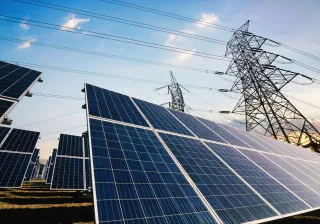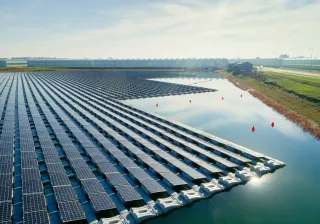“The future of African electricity will be dominantly [reliant on] renewable energy, especially solar”, said Fatih Birol, Executive Director, IEA (International Energy Agency), when the IEA report Africa Energy Outlook 2022 was released. Climate change, the structural changes brought about by the energy transition and acute crises pose obstacles for building a sustainable energy system in Africa, but they can be defused by means of research.
Africa has tremendous potential for using solar resources since up to 40% of the total global solar radiation reaching land areas hits Africa. Furthermore, as the prices of solar and wind power are coming down, Africa could gain major financial and humanitarian benefits from using these carbon-free generation resources. This would improve access to energy, enable clean cooking, provide energy for water desalination – turning seawater into potable water –, enhance industrial opportunities and help Africa grow into an exporter of solar-based green hydrogen.
In spite of the benefits, there are various challenges in sight for Africa when it comes to renewables. For example, Oxford University has estimated that in Africa only a 10% share of energy will come from renewable sources by 2030 unless immediate action is taken. The five-year EU project LEAP-RE aims to tackle obstacles to a transition to renewable energy in Africa by means of long-term cooperation and boosting of local research activities.
Satellite data tells the best spots for using renewable sources of energy
VTT is involved in the three-year OASES project, to be implemented as part of LEAP-RE, promoting the African energy transition by means of satellite data, machine learning and energy models. Collaborating with African and European partners, VTT is responsible for creating African energy models and developing modelling software. The challenges lie not only in the collection of data but also in making the models accessible to local operators. If the objectives are achieved, the project will provide local researchers with an open-source database and modelling software that can be used for studying and modelling optimised investments in local renewables production, transmission lines and reliability.
To put it simply, the basic idea of the project is to identify the existing power and solar installations from satellite data with the help of machine learning; to identify and analyse the ideal locations for future investments; and to use the data as a basis for city-, country- and continent-specific energy system models. This open-source model would then remain accessible to local researchers and other actors.
The project is part of a larger ambitious objective for building a sustainable African energy system.

2. Analysing the potential provided by the renewable sources of energy.
3. African energy models at the local, national and continental level.
“The project is part of a larger ambitious objective for building a sustainable African energy system. Africa is concurrently facing both acute crises and structural changes brought about by the energy transition and climate change. In addition to structural challenges, the access to data and necessary tools for African local researchers remains a problem. The PyPSA meets Africa project, for example, has done excellent work by creating an African open-source power grid model. Hopefully, we can continue this work in our project by collecting even more detailed data and expanding the model to cover also other energy sectors. After all, having the ability to model and anticipate system operation is the prerequisite for building a reliable system,” says VTT Research Scientist Nelli Putkonen, who is involved in the project.
The OASES project, launched in the summer of 2022, will continue until 2025. The progress of the project can be followed on the VTT project site and through the LEAP-RE website. The OASES project is funded by the Academy of Finland with the EU and coordinated by the German Fraunhofer Society.



For further information, please contact:
Nelli Putkonen, Research Scientist
[email protected]
+358504062926
Juha Kiviluoma, Principal Scientist
[email protected]
+358504116542
Read more about the modelling of energy systems done at VTT and how the work can contribute to solving global challenges on the website of the Design and Operation of Energy Systems research group.
To get acquainted with the open-source modelling tools developed by us visit also:








